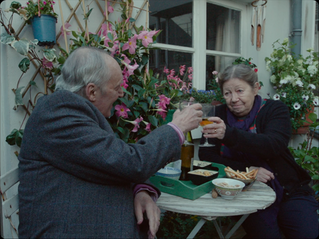Nora Ephron and Meg Ryan
- Lauren Mattice
- Nov 10, 2022
- 3 min read

According to the latest commercialization of nostalgia, it is “Meg Ryan fall.” The term was created as a play on a line from You’ve Got Mail, in which Ryan starred under the writing and direction of Nora Ephron. Through cycles upon cycles of social media posts, we are reminded to appreciate the autumnal outfits Ryan wore in You’ve Got Mail and other seminal romantic comedies, When Harry Met Sally and Sleepless in Seattle.
Though this appreciation often comprises nothing more than collages of turtlenecks or short clips of Ryan moving her wide-framed glasses to the top of her head. This format, in itself, cannot do much more than acknowledge and simultaneously create a spectacle that extricates Ryan from the films. What results is a transformation of Ryan, her role, and Ephron’s movies into what seems like a concerted effort to ooze femininity, fantasy and comfort — a transformation that erases the seminality of their partnership and the effect on the romantic comedy genre itself.
As a journalist and novelist, Ephron made a living in the late ‘60s and early ‘70s as a semi-antithesis to writers like Joan Didion; Ephron avoided complete cynicism to instead imbue each line she wrote with a sarcastic and dripping sense of “aside,” especially with regard to romantic situations. Each line mattered, and each word unspoken mattered, which made Ryan’s performance all the more critical.
In a classic When Harry Met Sally scene where Sally (Ryan) is telling Harry (Billy Crystal) about a dream that starts and ends when a faceless man rips off her clothes, she qualifies that the dream varies, and as Harry enquires “which part”, she responds: “what I’m wearing.” The scene is credible for its humor, but at the same time an example of the title characters’ exacting interactions that favor substance over sensuality, though not to either concept’s detriment. Indeed, the intimacy between the lines is what drives their relationship forward.
Shortly after Ephron’s death, Ryan spoke to the Hollywood Reporter about the dependency of her characters and their belief in the romantic myth being tethered to Ephron’s pen. “She earned that perfection, and it was her pleasure to earn it,” Ryan said. “You’d go, ‘God, if I just wrote down all the directions she’s whispering in my ear, you could submit them to The New Yorker.’ Not line readings; she would just sort of explain the sense of something. Sometimes it was nonverbal: a little less, a little more, faster, funnier, may emphasize this. It goes easier and easier, a shorthand. Always precise, funny, smart.”
Precision is foundational to the intimacy Ephron emphasizes in her films. In You’ve Got Mail, bookstore magnate Joe (Tom Hanks) and small-business owner Kathleen are comfortable getting to know each other behind the veil of online semi-anonymity. But when Joe brings Kathleen daisies to apologize for putting her out of business, his verbal apology concedes that the move “wasn’t personal.” Irritated, Kathleen responds, “I’m so sick of that…All that means is that it wasn’t personal to you. But it was personal to me.” Using this in-person interaction to emphasize no-holds barred honesty, Ephron contrasts the emptiness of romantic gesture to the intimacy of candidness – the latter truly giving rise to meaningful relationships.
What “Meg Ryan fall” does to this series of groundbreaking work, both within the genre and as written achievement, is reduce the impact of Ephron and Ryan’s work to fragments that should be consumed rather than appreciated in their fullness. The costume work by Gloria Gresham, Albert Wolsky and Judy Ruskin are fantastic in their own right, but when removed from the full mise-en-scene and performance, they are trivial and ephemeral — a criticism often charged to the romantic comedy genre itself.
Ephorn wrote in a 1973 Esquire column that she had “spent a great deal of my life discovering that my ambitions and fantasies—which I once thought of as totally unique—turn out to be clichés.” Ephron worked hard throughout her life to bring her words, and the media they were contained in, to life. Meg Ryan helped realize these efforts through more than posing and gesture — their working relationship set a high note in the genre that still gets reduced despite the movies’ triumphs against frivolity in every line and sequence.








Comments